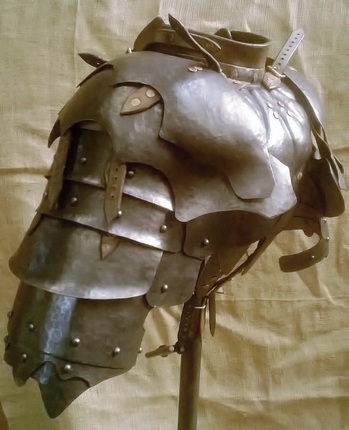Please see the photos and information on this piece below.
This diary has been published with the permission of the client.
All designs, forgings and photographs are the property of Caimbeuls's Forge and are therefore protected by Copywrite. If you would like to use a photograph please get in contact before use to obtain permission.
This diary has been published with the permission of the client.
All designs, forgings and photographs are the property of Caimbeuls's Forge and are therefore protected by Copywrite. If you would like to use a photograph please get in contact before use to obtain permission.
Introduction
This piece was commissioned for a Live Action Role Play (LARP) enthusiast. This commission has been a bit of an adventure as there are several rules governing LARP armour. The gauge of the material used determines whether or not the edges would need to be rolled for safety. Any articulated parts need all edges extending on the inside portion of the joint to prevent any scissoring action within the piece that may cause injury.
In order to prevent injury to participants or damage to the latex weaponry used in LARP, any features that would normally be pointed have had to be rounded slightly. There are also restrictions on the type and style of fixings or rivets to be used. This has not really affected they way I have done the piece, apart from ensuring that all rivet heads inside and out are safe and smooth to the touch to prevent injury and damage to the wearer and to the weapons used.
In order to prevent injury to participants or damage to the latex weaponry used in LARP, any features that would normally be pointed have had to be rounded slightly. There are also restrictions on the type and style of fixings or rivets to be used. This has not really affected they way I have done the piece, apart from ensuring that all rivet heads inside and out are safe and smooth to the touch to prevent injury and damage to the wearer and to the weapons used.
Templates
There are several tools open to the blacksmith to help convey their design ideas to the client. These include drawings, plasticine models, forged test pieces and templates. This piece was essentially an exercise in sheet metal work so templates were used first. There is almost as much work in the design of the templates as there is in the forging of the metal armour itself. This piece could not really have been done without a template design.
The early templates of the gauntlet were done at the start of the commission without full realization of the safety regulations required by LARP armour. The articulation of the first mitt produced would have instantly been rejected by LARP as a trapping point. After further consultation, a gorget (neck piece) and a set of pauldrons (shoulder armour) along with upper arm protection were agreed upon.
The early templates of the gauntlet were done at the start of the commission without full realization of the safety regulations required by LARP armour. The articulation of the first mitt produced would have instantly been rejected by LARP as a trapping point. After further consultation, a gorget (neck piece) and a set of pauldrons (shoulder armour) along with upper arm protection were agreed upon.
Forging
Once the templates were finalised, the forging process could start. The design was drawn out onto sheet metal then, using a band saw, it was cut out to create the different sections to be worked. During the forging, I am repeatedly referring back to the templates to ensure accuracy. Once the armour had been forged and put together, the client came in for a fitting and the piece was then further adjusted to fine tune the fit to the client.
All of the leather work on this piece was done by myself. Even before I started to blacksmith full time, I have always been using my hands to create things. This has meant that over the years I have learnt a wide variety of crafts, anywhere between leather work & flint knapping to bead work and knitting! This has enabled me to bring these skills into my passion for metal and enhance the work that I do.
Once the templates were finalised, the forging process could start. The design was drawn out onto sheet metal then, using a band saw, it was cut out to create the different sections to be worked. During the forging, I am repeatedly referring back to the templates to ensure accuracy. Once the armour had been forged and put together, the client came in for a fitting and the piece was then further adjusted to fine tune the fit to the client.
All of the leather work on this piece was done by myself. Even before I started to blacksmith full time, I have always been using my hands to create things. This has meant that over the years I have learnt a wide variety of crafts, anywhere between leather work & flint knapping to bead work and knitting! This has enabled me to bring these skills into my passion for metal and enhance the work that I do.
©2012-2022 Caimbeul's Forge
